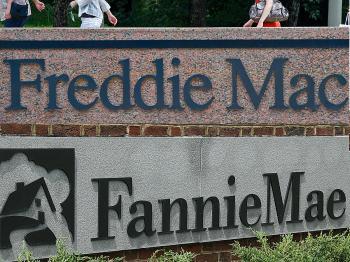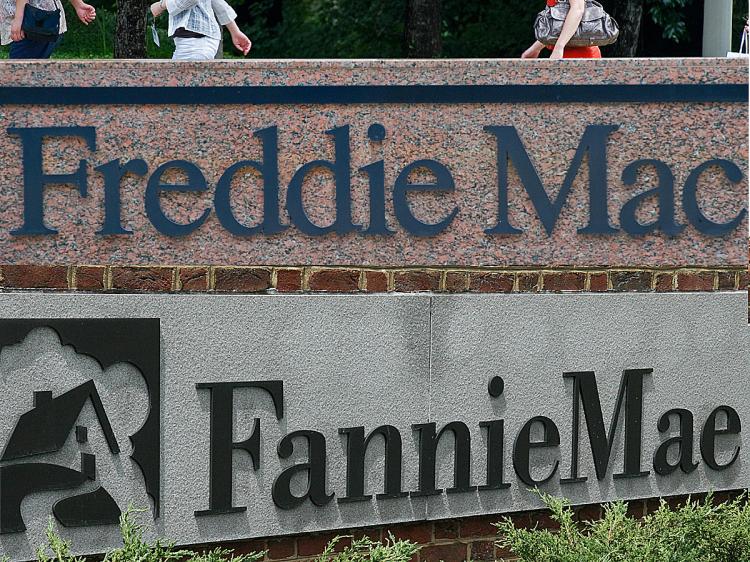WASHINGTON—It was a monumental fall for two companies, which for decades epitomized the booming U.S. real estate industry.
But last week, at the direction of the Federal Housing Finance Agency (FHFA), Fannie Mae and Freddie Mac were delisted from the New York Stock Exchange, becoming the latest reminders of the nation’s recent mortgage meltdown.
Fannie and Freddie were created by the U.S. government to make real estate more affordable for homeowners and together guaranteed around $12 trillion in U.S. mortgage debt.
In mid-2007, Fannie Mae’s shares still traded for $68. But the subprime mortgage crisis eroded the company’s financial position and by October 2008, the company’s stock was less than $1 per share. Freddie Mac’s shares have been below $1 since the beginning of 2008.
The federal agency downplayed the significance of the delistings. “A voluntary delisting at this time simply makes sense and fits with the goal of a conservatorship to preserve and conserve assets,” said Edward J. DeMarco, acting director at FHFA, in a recent statement.
Delisting generally comes into play when the stock price falls below a minimum average of $1 over a 30-day time period, an indication of a financially struggling organization.
Delisting is not the end of stock trading. Fannie and Freddie’s common and preferred stocks are still available through the Over-the-Counter Bulletin Board (OTCBB), but are considered to be “penny stocks.”
The OTCBB is an electronic trading vehicle provided by the National Association of Securities Dealers. These are stocks that carry a high degree of risk and do not meet the minimum net worth requirement of the New York Stock Exchange.
The “primary focus of Freddie Mac over the past year [has been] helping families avoid foreclosures,” said Charles “Ed” Haldeman Jr., CEO at Freddie Mac, in a speech published on the Freddie Mac website.
Continued funding for mortgages did not come to a grinding halt once both Freddie Mac and Fannie Mae were placed into federal conservatorship. The two firms provided liquidity to the market by underwriting 70 percent of the U.S. single-family and 90 percent of multifamily mortgages in 2009. By guaranteeing or buying $500 billion in mortgages and mortgage securities, Freddie Mac was responsible for over 2.5 million families owning a home.
Freddie Mac, despite owning about 25 percent of all U.S. mortgages, has a mortgage default rate of less than 10 percent. On the other hand, the private sector owns only 10 percent of all first mortgages, but experienced a 28 percent default rate.
Haldeman pointed to Freddie Mac’s performance stating, “The point I want to stress is that about 1 in 25 of our loans is seriously delinquent. That record puts us among the very best in the industry.”
“The centerpiece of our efforts is the Making Home Affordable Program, or MHA. It includes both a refinance program and an anti-foreclosure program,” he said.
The MHA refinance program is geared toward those who are not yet delinquent in their loan payments, but can’t refinance in the market. This program helped close to 170,000 families since its inception. Not only that, a total of 1.8 million families, using other Freddie Mac refinance programs, found more affordable interest rates.
Freddie has established a borrowers’ help program—a pilot program tested in areas with the highest U.S. delinquency rates, which has already helped 17,000 borrowers at risk of default.
Haldeman stressed that “We perform a vital mission for the nation ... our federal support does not enrich shareholders; instead, it helps us provide liquidity and keep families in their homes.”
In 2009, Fannie Mae pumped $800 billion into the market and provided over 40 percent of the U.S. home refinancing and purchase funds, helping over 3 million families, according to Michael J. Williams, president and CEO at Fannie Mae, in a 2010 speech given at Drexel University LeBow College of Business and published on the Fannie Mae website.
At the same time, Fannie Mae bought $83 billion of loans from smaller sized banks, which were bundled into securities to be sold to investors. In 2009, this firm found buyers for more than 120,000 foreclosed homes.
“We’ve been tasked with playing a major role in stabilizing the mortgage market and putting housing back on track,” Williams said.
In the beginning of June, the U.S. House of Representatives passed a bill to protect the public from predatory lending practices in the housing market and help American families buy a home.
“Families, neighborhoods and the nation’s housing market have been hurt by irresponsible lending and mortgage fraud schemes, and we need to make sure homebuyers are protected,” said U.S. Rep. Maxine Waters, D-Calif., in a June press release.
By the first quarter of 2010, other U.S. debt amounted to $8 trillion. At the same time, Fannie Mae and Freddie Mac’s combined debt equals the total U.S. debt, raising the total U.S. debt to $16 trillion, corresponding to 110 percent of the U.S. GDP.
Testifying before the House Financial Services Committee in March, Anthony B. Sanders, professor of finance at George Mason University said, “This ‘Grecian Formula’ of debt issuance to fund housing goals is not sustainable. We simply have too much leverage in the housing finance system.” Sanders’s testimony may be found on the House Financial Services Committee website.
Sanders calls for combining the affordable U.S. Housing programs under one umbrella, leaving Freddie Mac and Fannie Mae with a streamlined mission. Besides this, control at the two firms needs to be strengthened and oversight passed on to an authority that can’t be manipulated into submission by the two firms.
“We need to take immediate action to get the financial institutions and the investment community back in the game and wind down the Federal government’s involvement,” Sanders said.
But last week, at the direction of the Federal Housing Finance Agency (FHFA), Fannie Mae and Freddie Mac were delisted from the New York Stock Exchange, becoming the latest reminders of the nation’s recent mortgage meltdown.
Fannie and Freddie were created by the U.S. government to make real estate more affordable for homeowners and together guaranteed around $12 trillion in U.S. mortgage debt.
In mid-2007, Fannie Mae’s shares still traded for $68. But the subprime mortgage crisis eroded the company’s financial position and by October 2008, the company’s stock was less than $1 per share. Freddie Mac’s shares have been below $1 since the beginning of 2008.
The federal agency downplayed the significance of the delistings. “A voluntary delisting at this time simply makes sense and fits with the goal of a conservatorship to preserve and conserve assets,” said Edward J. DeMarco, acting director at FHFA, in a recent statement.
Delisting generally comes into play when the stock price falls below a minimum average of $1 over a 30-day time period, an indication of a financially struggling organization.
Delisting is not the end of stock trading. Fannie and Freddie’s common and preferred stocks are still available through the Over-the-Counter Bulletin Board (OTCBB), but are considered to be “penny stocks.”
The OTCBB is an electronic trading vehicle provided by the National Association of Securities Dealers. These are stocks that carry a high degree of risk and do not meet the minimum net worth requirement of the New York Stock Exchange.
Avoiding Foreclosures
The “primary focus of Freddie Mac over the past year [has been] helping families avoid foreclosures,” said Charles “Ed” Haldeman Jr., CEO at Freddie Mac, in a speech published on the Freddie Mac website.
Continued funding for mortgages did not come to a grinding halt once both Freddie Mac and Fannie Mae were placed into federal conservatorship. The two firms provided liquidity to the market by underwriting 70 percent of the U.S. single-family and 90 percent of multifamily mortgages in 2009. By guaranteeing or buying $500 billion in mortgages and mortgage securities, Freddie Mac was responsible for over 2.5 million families owning a home.
Freddie Mac, despite owning about 25 percent of all U.S. mortgages, has a mortgage default rate of less than 10 percent. On the other hand, the private sector owns only 10 percent of all first mortgages, but experienced a 28 percent default rate.
Haldeman pointed to Freddie Mac’s performance stating, “The point I want to stress is that about 1 in 25 of our loans is seriously delinquent. That record puts us among the very best in the industry.”
“The centerpiece of our efforts is the Making Home Affordable Program, or MHA. It includes both a refinance program and an anti-foreclosure program,” he said.
The MHA refinance program is geared toward those who are not yet delinquent in their loan payments, but can’t refinance in the market. This program helped close to 170,000 families since its inception. Not only that, a total of 1.8 million families, using other Freddie Mac refinance programs, found more affordable interest rates.
Freddie has established a borrowers’ help program—a pilot program tested in areas with the highest U.S. delinquency rates, which has already helped 17,000 borrowers at risk of default.
Haldeman stressed that “We perform a vital mission for the nation ... our federal support does not enrich shareholders; instead, it helps us provide liquidity and keep families in their homes.”
In 2009, Fannie Mae pumped $800 billion into the market and provided over 40 percent of the U.S. home refinancing and purchase funds, helping over 3 million families, according to Michael J. Williams, president and CEO at Fannie Mae, in a 2010 speech given at Drexel University LeBow College of Business and published on the Fannie Mae website.
At the same time, Fannie Mae bought $83 billion of loans from smaller sized banks, which were bundled into securities to be sold to investors. In 2009, this firm found buyers for more than 120,000 foreclosed homes.
“We’ve been tasked with playing a major role in stabilizing the mortgage market and putting housing back on track,” Williams said.
Governmental Reforms
In the beginning of June, the U.S. House of Representatives passed a bill to protect the public from predatory lending practices in the housing market and help American families buy a home.
“Families, neighborhoods and the nation’s housing market have been hurt by irresponsible lending and mortgage fraud schemes, and we need to make sure homebuyers are protected,” said U.S. Rep. Maxine Waters, D-Calif., in a June press release.
By the first quarter of 2010, other U.S. debt amounted to $8 trillion. At the same time, Fannie Mae and Freddie Mac’s combined debt equals the total U.S. debt, raising the total U.S. debt to $16 trillion, corresponding to 110 percent of the U.S. GDP.
Testifying before the House Financial Services Committee in March, Anthony B. Sanders, professor of finance at George Mason University said, “This ‘Grecian Formula’ of debt issuance to fund housing goals is not sustainable. We simply have too much leverage in the housing finance system.” Sanders’s testimony may be found on the House Financial Services Committee website.
Sanders calls for combining the affordable U.S. Housing programs under one umbrella, leaving Freddie Mac and Fannie Mae with a streamlined mission. Besides this, control at the two firms needs to be strengthened and oversight passed on to an authority that can’t be manipulated into submission by the two firms.
“We need to take immediate action to get the financial institutions and the investment community back in the game and wind down the Federal government’s involvement,” Sanders said.






